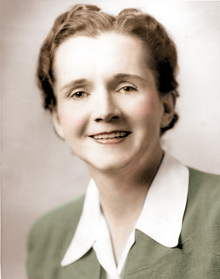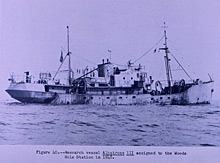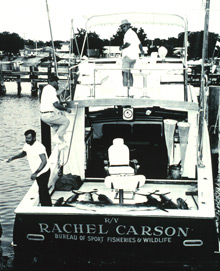Rachel Carson: Defender of the Environment
- Pioneering Scientist and Environmentalist
- Studying Marine Environments
- Carson's Rich and Lasting Legacy
Pioneering Scientist and Environmentalist

Best known for writing Silent Spring, ecologist and author Rachel Carson spent summers in college studying marine biology. She believed that all life is interconnected and that everyone is responsible for stewardship of the environment. Click image for larger view.
Rachel Carson (1907-1964) was a pioneer woman scientist in the federal government, a respected author, and a tireless advocate for the ocean environment who helped bring about lasting environmental change. She has often been referred to as “the mother of the age of ecology.” In her meticulously researched writings that range from poetic to scientific, Carson raised awareness of the natural world and the importance of environmental preservation. She dedicated her life’s work to understanding the impact of human activities on the environment and how environmental changes affected living organisms, including humans.
Studying Marine Environments
Rachel Carson was born in Springdale, Pennsylvania, in 1907 and spent her last years in Silver Spring, Maryland, the headquarters of today’s NOAA. After graduating from Pennsylvania College for Women in 1929, she spent summers studying at the Marine Biological Laboratory in Woods Hole, Massachusetts. She received a masters degree in marine zoology from Johns Hopkins University in 1932. In 1935, she became one of only two women scientists at the United States Bureau of Fisheries, a predecessor agency to NOAA’s National Marine Fisheries Service. There she wrote scripts for scientific papers, radio programs, pamphlets about marine life, and even cookbooks. Carson retired from the Bureau of Fisheries in 1952.

Rachel Carson and her literary agent were the first women to sail on the Albatross III research vessel. Carson wanted to experience the ocean in a different way than she could walking along the shore. The vessel had an overall length of 179 feet and a cruising range of 4,500 miles. Click image for larger view.
In 1949, she and her literary agent were the first women to ever sail aboard a government fisheries vessel, the Albatross III, for a research voyage to Georges Bank in the North Atlantic. Carson wanted to experience the ocean at a level different than she could walking along the shore. On this cruise she was able to see the diversity of the creatures collected; feel how the waves, winds, and currents interacted; and partake in this experience as a sailor, scientist, and fisher.
Carson based much of her writing on personal observation. She traveled the Atlantic coast from Maine to Florida, researching and exploring the various types of coastlines for one of her books, The Edge of the Sea. She was among the first to notice that the widespread use of pesticides like DDT seriously damaged our environment. Carson began researching and writing about the effects of pesticides in 1958 and began publishing a serial version of Silent Spring in the New Yorker magazine in 1962, two years before her untimely death. Publishing this work took great moral courage and integrity as special interests immediately attacked her science and even her sanity.Carson’s Rich and Lasting Legacy
One of Carson’s greatest talents was her ability to condense large amounts of scientific data and information into terms that the general public could understand and use. She is credited with making the concepts of ecology, the food chain, biosphere, and ecosystem familiar to the public and helping all understand that changes in the marine environment are linked to the economic and social well being of our communities.

Fittingly, the Bureau of Sport Fisheries and Wildlife Service named one of its research vessels in honor of the famed scientist Rachel Carson. Click image for larger view.
Her books have had a lasting effect on society. Silent Spring, Carson’s best known work, raised awareness of the issues of pesticide use in the United States at a time when pesticides were becoming more widely used. Carson clearly illustrated that the fate of humans is inextricably linked to the fate of the environment and garnered the attention of high-level government officials. By exposing pesticides’ lethal impacts on fish and birds and their deleterious effects on human health, Silent Spring led to banning the use of DDT in the United States, regulating pesticide use, and the political climate that led to establishing the Environmental Protection Agency and elements of NOAA.
Her writings Under the Sea Wind and The Edge of the Sea, focused on marine organisms and instilled knowledge and appreciation of the ocean and marine life. The Sea Around Us described the ocean as part of the great system of earth, atmosphere, and ocean, making life on earth possible as we know it. But Carson was also becoming aware of threats to the marine environment as she wrote:
“It is a curious situation that the sea, from which life first arose, should now be threatened by the activities of one form of that life. But the sea, though changed in a sinister way, will continue to exist; the threat is rather to life itself.”
This book made The New York Times bestseller list within two months of its June 1951 publication and remained there for 86 weeks.
Through her ability to explain the interconnectedness of nature, her courage, and her integrity, Rachel Carson has inspired generations of scientists, policy-makers, and educators. Because of pioneers like her, many people today study the marine environment and strive to conserve its ecosystems and organisms. Carson’s spirit lives on through her writings, teaching us to learn all we can of the environment, to respect all life, and to protect and conserve the environment for future generations.









